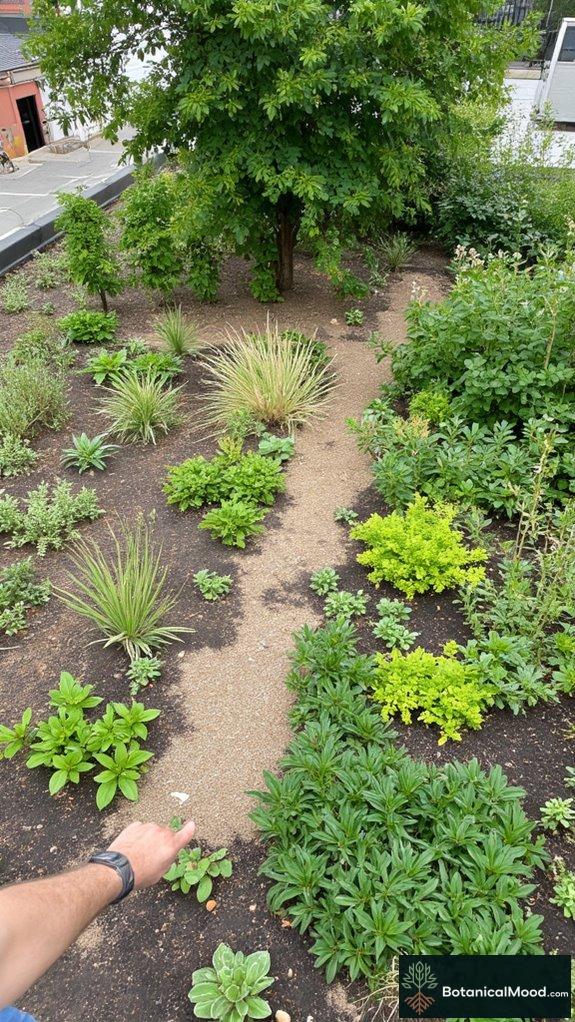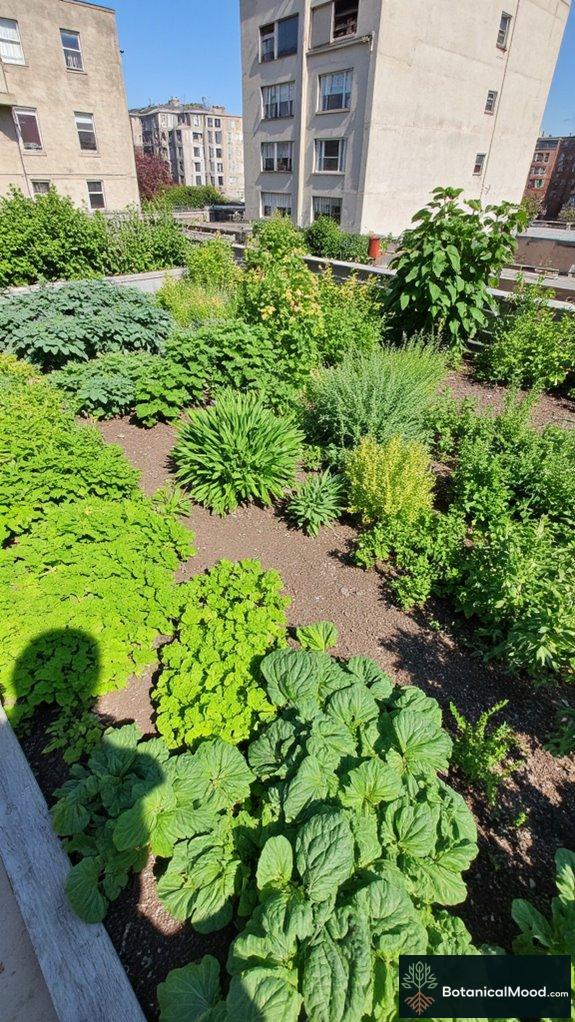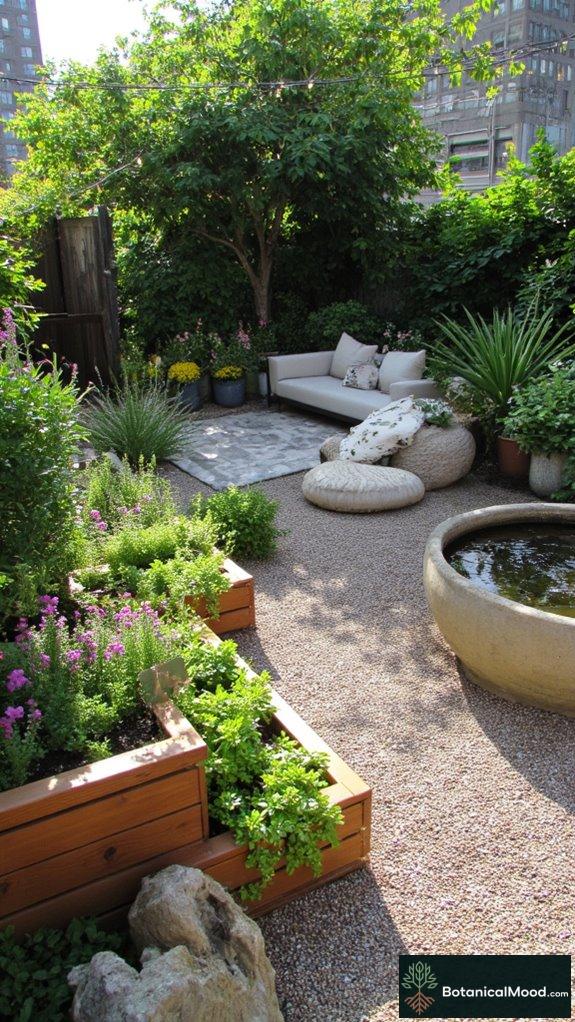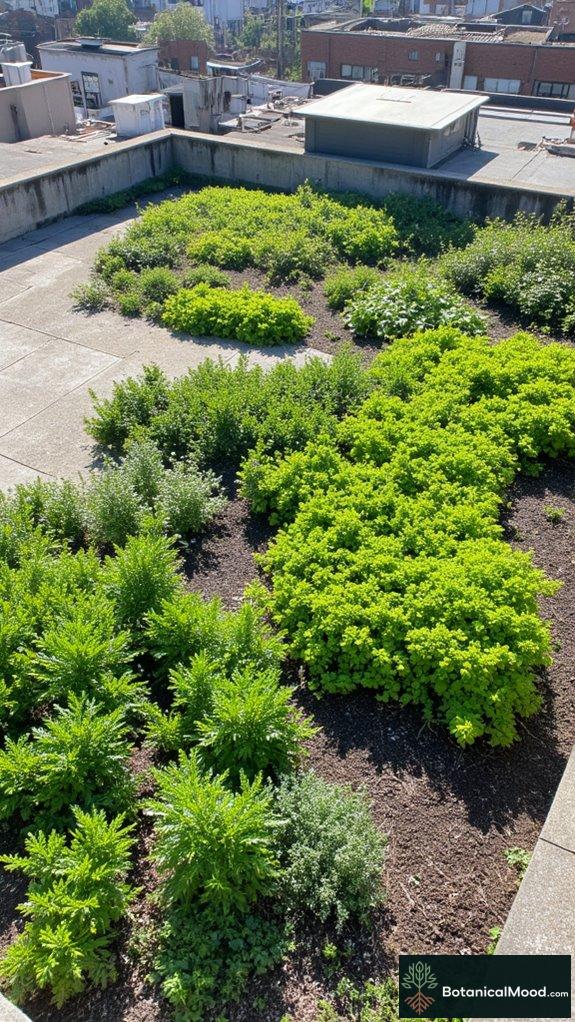Who knew rooftops could be so… tasty?
I mean, here I was, another city dweller, rolling my eyes at those concrete jungles. Then I stumbled upon Brooklyn Grange and, well, let’s just say I started growing my own herbs—sorry, grocery store!
Not only are urban green roofs a feast for the eyes and the stomach, but they also help fight stormwater runoff. Who knew my basil could be a superhero?
Feeling curious yet?
Sure, it’s messy—weeds are basically my arch nemesis—but what’s more satisfying than tossing freshly-grown veggies into my salad?
My Urban Garden Design Adventure
Last summer, I decided to tackle my tiny balcony with a DIY garden makeover. Picture this: a sprinkle of colorful pots bursting with tomatoes, basil, and peppers! I spent hours carefully arranging them—strategically designed, of course—to maximize sunlight. I even stumbled upon vertical gardening solutions, which honestly felt like I was creating a Pinterest board come to life.
To my surprise, my tomato plants flourished, and I hosted a miniature harvest party (complete with my homemade caprese salad). It was like a “farm-to-table” experience, only, you know, my table was a quaint balcony in the heart of the city. Urban gardening isn’t just about aesthetics; it’s about crafting a slice of fresh, green paradise amid the urban chaos.
Quick Takeaways
- Green roofs enable urban agriculture, allowing residents to grow fresh fruits and vegetables directly on rooftops, fostering local food production.
- Integrating edible plants enhances urban sustainability, transforming barren concrete areas into lush, productive green spaces that improve community engagement.
- Modular green roof systems support diverse plant palettes, making it easier to incorporate vegetables and herbs into urban landscapes while promoting biodiversity.
- These gardens provide aesthetic benefits, transforming dull urban environments into vibrant, inviting landscapes that encourage outdoor activities and social interaction.
- By reducing food miles and reconnecting communities with nature, green roofs significantly contribute to urban food security and resilience.
The Growing Green Roof Market

The market for green roofs is expanding at an impressive rate, reflecting a growing awareness of sustainable architecture and urban biodiversity.
As urban environments evolve, I’ve noticed architects incorporating innovative systems like modular green roof components and extensive vegetation palettes, featuring native plants that enhance biodiversity.
Companies like LiveRoof and GreenGrid are pioneering projects, showcasing flexible designs that accommodate a variety of climates.
Innovative companies like LiveRoof and GreenGrid are leading the way in versatile green roof designs for diverse climates.
With the advancement of irrigation technology and soil compositions, the integration of edible plants into these rooftops is becoming more achievable. In fact, top fruit trees specifically chosen for small urban gardens can thrive in these green spaces, providing both beauty and nourishment.
This dynamic shift not only fosters sustainability but also amplifies aesthetic value, transforming our concrete jungles into vibrant living spaces.
Benefits of Green Roofs for Urban Environments

Green roofs offer a remarkable solution to the challenges of urban living by enhancing environmental quality and aesthetic appeal simultaneously.
They provide:
- Biodiversity: By incorporating diverse plants, green roofs create microhabitats for birds and insects, promoting urban ecology.
- Urban Agriculture: These innovative designs allow residents to grow vegetables, herbs, and fruits, fostering community engagement and food security.
- Visual Enhancement: Picture vibrant succulents intermingling with colorful wildflowers, transforming sterile concrete into lush environments.
In my journey of exploring gardening through Botanical Mood, I admire how these green spaces reinvigorate our urban environments, offering both functionality and beauty.
Environmental Impact and Energy Efficiency

As urban areas continue to grapple with the consequences of climate change and resource depletion, I’ve noticed how integrating green roofs into city infrastructures can considerably reduce energy consumption and lower carbon footprints. These innovative designs not only insulate buildings, maintaining cooler interior temperatures during hot summers and reducing heating needs in winter, but also absorb rainwater, mitigating stormwater runoff. Brands like LiveRoof and Green Roof Outfitters have revolutionized this eco-friendly movement, crafting modular systems that simplify installation. Incorporating diverse plant species, such as sedums and native wildflowers, creates vibrant habitats, demonstrating that sustainability and beauty can coexist harmoniously in our urban environments. Additionally, modern landscape lighting can enhance the aesthetic appeal of green roofs during the evening, transforming them into stunning urban retreats.
Urban Agriculture and Food Security

Urban agriculture not only enhances food security but also contributes greatly to the greening of city environments, a concept that seems increasingly essential in today’s world.
Imagine a thriving urban environment where we can:
- Cultivate fresh vegetables on rooftops, reducing food miles dramatically.
- Engage communities through garden initiatives, fostering collaboration and innovation.
- Enhance biodiversity by integrating pollinator-friendly plants into our urban spaces.
As I explore these transformative possibilities, I recognize the beauty and functionality that urban agriculture offers, making our cities not just livable, but vibrant and resilient.
It’s an inspiring way to reconnect people with nature and nourish our communities.
Social and Health Advantages of Green Roofs

The integration of lush greenery atop our buildings can transform not just the aesthetic of urban environments but also enhance the social fabric and health of the communities below.
Green roofs aren’t merely visual masterpieces; they serve as essential communal spaces, fostering interactions among diverse residents.
By creating serene environments, they reduce stress and promote mental well-being. Studies show that exposure to plants can enhance cognitive function and boost productivity.
Furthermore, they naturally regulate temperatures, improving air quality by removing pollutants.
As I explore innovative gardening techniques, I’ve witnessed how these living roofs cultivate connections and contribute to a healthier urban lifestyle.
Economic Considerations and Long-Term Savings

While many might initially view green roofs as simply an aesthetic enhancement for buildings, I’ve come to appreciate their profound economic advantages and long-term savings potential.
The investment in green roofs pays off considerably through:
Investing in green roofs yields significant returns through energy savings, stormwater management, and increased property value.
- Energy Efficiency: They reduce heating and cooling costs by providing natural insulation, leading to lower utility bills.
- Stormwater Management: Green roofs capture rainwater, reducing runoff and lessening the need for expensive drainage systems.
- Increased Property Value: Properties with green roofs have a higher appeal, attracting sustainable-minded buyers and offering potential for higher rent.
Through my site, Botanical Mood, I explore these benefits, illustrating how innovation in design matters.
Innovations and Future Trends in Green Roofing

As green roofing continues to gain traction, innovative approaches are reimagining the possibilities of living architecture.
For instance, modular green roof systems, like those from companies such as Green Roof Technologies, allow for quick installation and customizable designs, creating dynamic living spaces. Advances in irrigation technologies, utilizing smart sensors for ideal water management, enhance plant health and conserve resources.
Moreover, innovative plant selections, focused on native and drought-resistant species, improve biodiversity while reducing maintenance.
As I curate content for Botanical Mood, I find it inspiring how these trends inspire urban dwellers to cultivate their connection with nature, transforming rooftops into lush, productive ecosystems.
Innovative Urban Garden Layouts

Innovative urban garden layouts are reshaping the way we perceive and interact with green spaces in densely populated areas, ultimately creating sanctuaries that blend functionality with aesthetic allure.
- Plant Density: Striking a balance in plant density enhances visual appeal, guiding psychological connection. Additionally, enhancing urban habitats through effective plant landscaping can significantly improve ecological environments and overall quality of life in densely populated areas urban habitats.
- Smart Technology: Implementing intelligent features, like adaptive lighting, fosters ecological harmony and an engaging user experience.
- Equity Focus: Designing spaces that prioritize access encourages diverse community participation and fosters food security.
Case Study: Vertical Garden Success

Urban environments are rapidly transforming, and one of the most striking examples of this change is the rise of vertical gardens, which not only beautify but also optimize the limited space available in metropolitan areas.
Take the Bosco Verticale in Milan, featuring over 700 trees and 20,000 plants that create microclimates.
Or One Central Park in Sydney with its impressive 21-story green wall that boosts energy efficiency.
These vertical gardens do more than enhance aesthetics; they improve local air quality, reduce urban heat, and can even provide fresh vegetables.
Each project demonstrates the potential of sustainable innovation in urban gardening.
Rooftop Garden Spatial Arrangements

Rooftop gardens represent a remarkable opportunity to redefine urban environments while maximizing limited space, drawing on innovative design strategies.
I often envision these gardens divided into distinct zones for various activities:
- Outdoor dining areas framed by lush greenery.
- Lounging corners nestled under elegant pergolas for shade and privacy.
- Play spots decorated with vibrant mini meadows, inviting diverse wildlife.
Integrating softscapes like curving benches and water features enhances comfort while sharp architectural lines fade away.
In doing so, these spatial arrangements create tranquil havens that encourage community interaction, reflecting the beauty and complexity of urban gardening, which inspired my work at Botanical Mood.
Sustainable Rooftop Garden Design

Creating a sustainable rooftop garden design involves a harmonious blend of nature and architecture, catering to both aesthetic pleasure and functional resilience.
First, I assess structural and load considerations, ensuring the rooftop can manage the weight of soil and plants, and I utilize lightweight materials.
Next, I integrate efficient water management systems. Incorporating drought-resistant plants like sedums or hardy herbs not only conserves water but also enhances biodiversity.
Using solar-powered lighting captures renewable energy, while repurposed materials contribute to a greener footprint.
Ultimately, I create a haven that’s as beautiful as it’s sustainable, reflecting my passion for innovative gardening.
Decoration With Urban Rooftop Garden Transformations

Incorporating decorative elements into a rooftop garden transforms it from a mere green space into a vibrant sanctuary.
Consider these innovative features to elevate your garden:
- Custom Planters: Utilize integrated lighting and seating, like the Baltic rooftop in Park Slope, for multifunctional use.
- Relaxation Zones: Create cozy lounge areas with hammocks and aromatic plants, ensuring comfort while soaking in nature.
- Water Features: Integrate subtle lighting and small ponds for tranquility, enhancing overall aesthetic appeal.
Through these designs, every corner of the rooftop can tell a story, showcasing beauty and functionality while nurturing your urban oasis.
Meet the Garden Visionary

Molly Meyer, an acclaimed Green Roof Professional from Minneapolis, developed her passion for creating lush urban gardens through her background in ecological landscaping and experience in sustainable architecture.
To bring her vision to life, Meyer collaborated with site designers and clients, emphasizing native plant selection and sustainability. The garden design process involved detailed planning around structural load, drainage systems, and climate conditions to guarantee a thriving ecosystem atop the urban rooftop.
Meyer utilized tools such as soil moisture meters and garden design software, partnering with brands like LiveRoof for modular green roof systems.
Meyer incorporated advanced tools and strategic partnerships to enhance her urban green roof designs.
Furthermore, she consulted with horticulturists specializing in native plants to curate a diverse and resilient garden environment.
Renowned Garden Innovators and Brands

Green roofs have become an essential part of modern urban scenery design, merging functionality with aesthetic appeal.
Companies like Optigreen, with its innovative drainage systems and vegetation mats, and Bauder Flat Roofs, renowned for its quality flat roofing solutions, are at the forefront of this change.
Sempergreen and American Hydrotech offer groundbreaking concepts like vegetation blankets and the Garden Roof Assembly, promoting sustainable urban greenery.
Meanwhile, AD Greenroof LLC, led by Angie Durhman, showcases the importance of expert consultation in this developing field.
These innovators pave the way for greener cities, reflecting a vision I deeply resonate with through Botanical Mood.
Garden Design FAQ
How Do Green Roofs Impact Local Wildlife and Biodiversity?
Green roofs notably enhance local wildlife and biodiversity by creating unique microhabitats in urban settings.
I’ve observed how the diverse plant species, like native sedums and pollinator-friendly flowers, attract various pollinators, including bees and butterflies.
These roofs also offer refuge to birds seeking nesting sites and foraging grounds.
What Types of Plants Are Best Suited for Green Roofs?
When selecting plants for green roofs, I’ve found that sedums, succulents, and native grasses flourish beautifully.
These resilient species, with their drought-resistant qualities, thrive under the harsh sun while offering vibrant colors and textures.
I particularly admire the way creeping thyme spills over edges, resembling a lush, green waterfall.
For ideal biodiversity, I recommend incorporating flowering plants like Echinacea or Coreopsis, enriching both the aesthetics and habitat for local pollinators.
How Do Maintenance Requirements Compare to Traditional Roofs?
Maintaining green roofs isn’t as intimidating as some might think. Unlike traditional roofs, which often require minimal upkeep, green roofs thrive on proper irrigation, drainage checks, and seasonal plant care, regularly ensuring vibrant growth.
I’ve found that investing in quality native species reduces maintenance efforts, making them more sustainable. Brands like Zinco offer excellent drainage systems and growing media, enhancing both aesthetics and functionality.
Through my journey in gardening, I revel at how these environments truly evolve.
What Is the Typical Lifespan of a Green Roof Installation?
Typically, a well-installed green roof lasts 30 to 50 years, depending on materials and maintenance.
Smart selections like drought-resistant sedums or vibrant native flora enhance longevity.
I’ve discovered that proper drainage and regular upkeep, including eliminating weeds and ensuring plant health, can further extend its lifespan.
In my pursuit of innovative design, I created Botanical Mood to celebrate such eco-friendly options, inspiring others to embrace the beauty of sustainable environments.
Can Green Roofs Be Integrated With Renewable Energy Systems?
Absolutely, I’ve seen how green roofs can integrate seamlessly with renewable energy systems like solar panels.
By positioning solar arrays alongside lush vegetation, one can maximize space and foster energy efficiency.
For instance, innovative designs allow for dual-use, where growing native plants enhance biodiversity while supporting solar energy generation.
With companies like Unconventional Materials specializing in eco-friendly installations, it’s exhilarating to witness this sustainable synergy flourish in urban environments.
References
- https://www.grandviewresearch.com/industry-analysis/green-roof-market
- https://www.nature.com/articles/s42949-024-00159-8
- https://www.datamintelligence.com/research-report/green-roof-market
- https://www.verifiedmarketreports.com/blog/top-7-trends-in-green-roof/
- https://gba.org/resources/green-building-methods/exterior-solutions/green-roofs/
- https://onlinelibrary.wiley.com/doi/10.1155/2022/2430067
- https://pmc.ncbi.nlm.nih.gov/articles/PMC9578910/
- https://www.frontiersin.org/journals/sustainable-food-systems/articles/10.3389/fsufs.2022.923079/full
- https://raleighrealty.com/blog/gardening-statistics-trends
- https://pmc.ncbi.nlm.nih.gov/articles/PMC9448568/

Leave a Reply